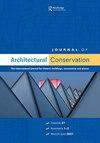Tirana National Theatre: chronicle of an announced demolition
IF 1
3区 艺术学
0 ARCHITECTURE
引用次数: 0
Abstract
ABSTRACT Tirana National Theatre was demolished on 17 May 2020. For the previous eighty years and up to that moment, it had maintained its public and societal function, documenting the changes of twentieth-century Albanian history. The Theatre was inaugurated in 1938, during the Italian Protectorate, as part of the Italian-Albanian Circolo Scanderbeg, a multifunctional complex conceived for entertainment as well as for Fascist propaganda. The construction, by the Italian company PATER, used a prefabricated system that well-exemplified the new building technologies and material research developed under the Fascist autarchy restrictions. This paper deals with the construction history of this building approaching questions around fabrics which significance is neglected in favour of new developments. Even if time-specific, architecture is often characterized by a lifespan that is longer if compared to its original construction purpose. Hence, despite the denial of any possible conservation or reuse, the Theatre’s cultural resilience and architectural, historic, and societal significance will continue to reverberate in the void created by its demolition. Unpretentiously, this paper honours the memory of a disappeared twentieth-century architecture, which ambiguous protection history was overcome by a much more sincere guardianship by the civil society and conservation community.地拉那国家剧院:宣布拆除的编年史
地拉那国家剧院于2020年5月17日拆除。在过去的八十年里,直到那一刻,它一直保持着它的公共和社会功能,记录着二十世纪阿尔巴尼亚历史的变化。该剧院于1938年在意大利保护国期间落成,作为意大利-阿尔巴尼亚Circolo Scanderbeg的一部分,这是一个多功能的综合设施,用于娱乐和法西斯宣传。该建筑由意大利公司PATER建造,使用了预制系统,很好地体现了在法西斯专制限制下开发的新建筑技术和材料研究。本文讨论了这座建筑的建造历史,探讨了围绕织物的问题,这些问题的重要性被忽视了,有利于新的发展。即使是特定于时间的建筑,与最初的建造目的相比,其寿命也往往更长。因此,尽管拒绝任何可能的保护或再利用,剧院的文化弹性和建筑,历史和社会意义将继续在其拆除造成的空白中回响。本文谦逊地纪念了一座消失的20世纪建筑,民间社会和保护社区更加真诚地守护了这段模糊的保护历史。
本文章由计算机程序翻译,如有差异,请以英文原文为准。
求助全文
约1分钟内获得全文
求助全文

 求助内容:
求助内容: 应助结果提醒方式:
应助结果提醒方式:


